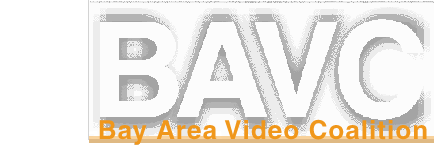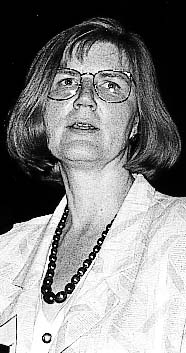
March 29, 1996, Afternoon
 (MISSING: Presentation by Connie Brooks of Stanford University
Libraries).
(MISSING: Presentation by Connie Brooks of Stanford University
Libraries).
MAN: ...So we did five tapes, we looked at them, we did them in different ways. We sat down and she had to educate me about her choreography and about what's important, what isn't important, and how all this works. Because this assuming that the company that's doing the restoration knows anything about the subject is really wrong. We just don't have a clue in some cases.
CONNIE BROOKS: Well, and also, wouldn't it sometimes be useful just to be told "we have no idea what the artist's intent was?" So that you realize that you're not missing something - that the person handing it over to you doesn't know either.
WOMAN: But, with a little bit of effort - this is still a relatively young medium, and if the maker of the work is not available, there are witnesses. I mean, there still are people around that saw the original presentation of that work. That's why I think it's so important to identify the people involved.
CONNIE: And this may vary from video art to documentary footage, where it may be a little harder in some cases. Yes?
WOMAN: This is something we discussed at AMIA. What about when you take a piece of film and you restore the color? And you change the way it originally looked?
CONNIE: We talked quite a bit about that in the working group, and couldn't because it's truly an ethical dilemma, and we just kind of ended up saying, well we don't know, but document it. At least make sure that people know they're not looking at the way it was originally done. Are there any other questions? Yes, Tom?
TOM: I don't know the extent to which writers and artists vary in this, but I believe that if you went to a writer twenty years after he wrote a piece, and asked for help in restoring it, you wouldn't get the original piece, you'd get a new one. This varies from writer to writer, but there is going to be something new brought into it, there are going to be improvements, there's going to be loss of memory. It's rather slick to say, well, go back to the original artists for guidance. This may be, in fact, the worst direction to go.
CONNIE: That's true, although to a certain degree, when you're going to be making changes yourself, that may be governed a little bit by law, in terms of - I'm not that familiar with all the legal aspects.
In our little working group, we spent about half an hour talking just about that subject, and in our working group, we more or less agreed that the original - we used the theater analogy, where it was like, whatever was actually presented to the public would be the original. And then we said, what if it's, like it opened in New Haven before it moved to New York, and we decided that was part of the pre-being presented to the public, although you would say that if you were in New Haven that you were the public. And then we started saying, maybe it's more like a publishing analogy, where the item that you would restore is the thing that was presented to the public in printed form, however, it's not like you wouldn't want to preserve all the manuscripts, because they show a very important part of the creative process. So, even though we more or less said it was what was presented to the public, we also agreed that we would want to preserve a whole lot of everything else. And that's why the group that Debbie is heading up, and you'll hear from a little later, is so important, because you have to make some priorities and they will be different from area to area. I imagine you would want to save more in video art than you might in a lot of other areas. Yes.
WOMAN: Media Alliance has been working with NAMID on a cataloguing project and a lot of that discussion about language is obviously occurring within a number of different groups. And talking about similar issues: original, master, dub master, submaster, viewing copy, reference copy, etc., and everybody having different ideas about what that means - source material, primary material - all these terms. And I'm just wondering if there's traditionally any context for cooperation between the archivists and the conservators, or if this is a special case. The conservators want to define those terms, too, right? Because it's in everybody's best interest to have a common language.
CONNIE: I think there's a history of cooperation between the organizations. I'm not sure about the specific issue of terminology. I think one of the problems we run into is not lack of good will, but a lot of people only have enough money to go to one conference a year. And so it's hard for people to make the connections, but there is a conservation section within the Society of American Archivists. And within the American Institute for Conservation, there is a section that deals specifically with - Maria, what's the title of it? - Library Collections something, and focuses more on the problems specifically of libraries and archives, which tend to hold different types of materials than museums. I would very much like to see more active cooperation between the people in this room and AIC, the American Institute for Conservation, which I think has a good broad framework within which this could fit - there are specialty groups within AIC, and there isn't one for videotape or for magnetic media, and I think it might be time. And I think librarians and archivists are trying to turn their attention more to it, but we're a little bit like ostriches sticking our heads in the sand, because, this stuff costs a lot of money. I was raised to think about how brittle books were such a problem, and brittle books outlast this stuff by a long shot. Yes, Jim?
JIM: I want to get back to - changing the subject - the issues of image manipulation from an ethical standpoint and further, digital noise reduction and the impact... And just bring up that it's an extremely important area because the tendency is to "make it look as good as it can." And there are some machines that literally have digital noise reduction built into them. In some of the newer machines, you can't even turn it off - it's there. And I see that as a continuing trend. And I'm very concerned about - sort of my favorite way of describing it is to look at a tape that was recorded in 1969, and viewing that tape in 2050 with digital noise reduction that was put in 1996. And I'm very concerned that from an ethical standpoint, not because people try to be unethical, but rather the technology is sort of forcing work to be done in a certain way that will change the way we view the work in the future. I don't have any solutions for it, but I wanted to raise the issue because it is very important. A lot of the new equipment, you really don't have a choice. It's there, it's built in, that's it.
CONNIE: That's a problem we often have, in that the archival and preservation fields, for instance, don't drive industry. We say what we want, but we're not a big enough market to often change it, although you were interested earlier - you mentioned that you would like to explore approaching manufacturers and vendors about some of these issues, and I think that's a worthwhile activity. I notice it's four o'clock, so maybe I'll get down from the podium before Karen gives me the hook. Thank you.